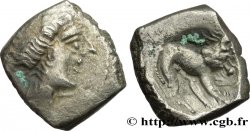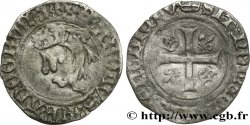bga_276743 - ITALY - TRANSPADANE AREA - CELTO-LIGURIANS Litra au quadrupède, imitation de Marseille, type Pautasso 22
Not available.
Item sold on our e-shop (2013)
Price : 520.00 €
Item sold on our e-shop (2013)
Price : 520.00 €
Type : Litra au quadrupède, imitation de Marseille, type Pautasso 22
Date: IIIe-IIe siècle avant J.-C.
Metal : silver
Diameter : 13,5 mm
Orientation dies : 1 h.
Weight : 0,83 g.
Rarity : R3
Coments on the condition:
Très belle monnaie sur un flan large et légèrement scyphate, mais ébréché en bord de flan. Patine de collection ancienne, avec de légers restes de concrétions sombres
Obverse
Obverse legend : ANÉPIGRAPHE.
Obverse description : Tête de Diane à droite, la chevelure bouclée, avec pendants d'oreille et un collier.
Reverse
Reverse legend : ANÉPIGRAPHE.
Reverse description : Quadrupède au corps pointillé à gauche, un astre à quatre rayons au-dessus ; double ligne d’exergue chevronnée.
Commentary
Ce type de monnaie est excessivement rare ; c’est la première fois que nous proposons une division celto-ligure. Les collections de Lyon et de Zurich, pourtant bien fournies en drachmes celto-ligures, en sont dépourvues...
Le style de la tête est particulièrement classique, très proche de celui des drachmes lourdes de Marseille. Le revers est quand à lui très différent, avec cet animal. Le style du droit est bien meilleur sur cet exemplaire que sur les n° 32 à 37 du Pautasso !.
This type of coin is extremely rare; this is the first time we have offered a Celto-Ligurian division. The collections of Lyon and Zurich, although well supplied with Celto-Ligurian drachmas, are devoid of them... The style of the head is particularly classical, very close to that of the heavy drachmas of Marseille. The reverse is very different, with this animal. The style of the obverse is much better on this example than on nos. 32 to 37 of the Pautasso!
Le style de la tête est particulièrement classique, très proche de celui des drachmes lourdes de Marseille. Le revers est quand à lui très différent, avec cet animal. Le style du droit est bien meilleur sur cet exemplaire que sur les n° 32 à 37 du Pautasso !.
This type of coin is extremely rare; this is the first time we have offered a Celto-Ligurian division. The collections of Lyon and Zurich, although well supplied with Celto-Ligurian drachmas, are devoid of them... The style of the head is particularly classical, very close to that of the heavy drachmas of Marseille. The reverse is very different, with this animal. The style of the obverse is much better on this example than on nos. 32 to 37 of the Pautasso!








 Report a mistake
Report a mistake Print the page
Print the page Share my selection
Share my selection Ask a question
Ask a question Consign / sell
Consign / sell
 Full data
Full data















